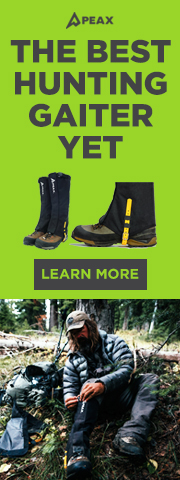Ok, we have all seen some of Brad\'s (cnelk) tree stand pictures. The stands are all quite low to the ground to my way of thinking. I suspect his tall son can just about do chin ups on some of them. Well, maybe I exaggerate just a little there, but you get the idea. Where I hunt those stands would be the recipe for tag soup. Even the squirrels would be chuckling, when they see him in one of those. Assuming both Brad and I have enough experience to know what works where we hunt, why do you think he can get away with those low tree stand heights, and I usually can\'t? What is wrong with the squirrels in his area, that they don\'t see the humor in those stands?
Navigation
Install the app
How to install the app on iOS
Follow along with the video below to see how to install our site as a web app on your home screen.
Note: This feature may not be available in some browsers.
More options
You are using an out of date browser. It may not display this or other websites correctly.
You should upgrade or use an alternative browser.
You should upgrade or use an alternative browser.
Why?
- Thread starter Swede
- Start date
iccyman001
New member
- Apr 30, 2014
- 5,489
Well,
Elevation and terrain play into this.
Where Brad hunts, it could be reletivly flat. So you are not worrying about elk seeing you moving as they are coming down a hill, over a ridge, etc.
I\'m guessing your area has more terrain and that is why you are up higher?
Elevation and terrain play into this.
Where Brad hunts, it could be reletivly flat. So you are not worrying about elk seeing you moving as they are coming down a hill, over a ridge, etc.
I\'m guessing your area has more terrain and that is why you are up higher?
cohunter14
Administrator
- Jul 10, 2017
- 5,325
I would also think the time of day you are sitting them and the wind play big roles. I haven\'t seen many pictures of your tree stands Swede, but what I have noticed from most of cnelk\'s is that they are in flatter areas. I also know that he tends to sit them only in the evenings, so I would have to assume that he is able to position them where he knows he is going to be downwind from where the elk come in. It would be just like someone using a ground blind in a small meadow - you don\'t want to be sitting on the upwind side of the meadow if you are hoping elk will come into the meadow.
I have hunted whitetails my whole life from treestands. Some folks have looked at my stands and said they were too low. I have also used climbers and climbed high. In my opinion, knowing the direction your game will approach and hiding the stand is the key. I have had so many deer under me as low as 15 feet and they never had a clue. I have also hinted with guys who have hung their stands extremely high and they looked like crows perched up in the top of a tree. I don\'t think height has anything to do with the effectiveness of a treestand. It\'s just making it blend in relative to the approach of the game and being ready when for the shot. At least that\'s how it works in my part of the country. Before I broke my arms and became a little less than enthused about climbing trees, I probably averaged about 25\'. Now my average stand is somewhere around 18\'. I still just have just as many deer under me.
Any tree stand location should have knowledge of your scent and the scent cone.
If you are in a spot that has fickle winds, your scent cone will be greater than if you have predictable winds.
You guys are very observant. My stands are in flatter terrain.
And of course I like flat and so do elk.
Your scent cone can be wide with just a thermal but very narrow with a slight breeze.
Be aware of the nearby terrain that will pull your scent cone one way or another.
If you are in a spot that has fickle winds, your scent cone will be greater than if you have predictable winds.
You guys are very observant. My stands are in flatter terrain.
And of course I like flat and so do elk.
Your scent cone can be wide with just a thermal but very narrow with a slight breeze.
Be aware of the nearby terrain that will pull your scent cone one way or another.
You guys are just too smart for me. I figured there would be some pretty wild guesses, but you all hit it out of the park. Derek is right about not seeing many of my tree stand pictures. The truth is that I am very poor about taking photos. I wish I did better, but never seem to get around to it. My bad.
cohunter14
Administrator
- Jul 10, 2017
- 5,325
\"Swede\" said:You guys are just too smart for me. I figured there would be some pretty wild guesses, but you all hit it out of the park. Derek is right about not seeing many of my tree stand pictures. The truth is that I am very poor about taking photos. I wish I did better, but never seem to get around to it. My bad.
Swede, I made it a point this year to try to take more pics...and I still didn\'t take enough! So I know how you feel for sure.
Swede, do you think a ground blind may have worked better than the tree stand ? The reason I ask is because I have used portable ground blinds when antelope hunting. On several occasions, I have had mule deer come to water and circle my blind from all directions as close as 10 yards. They seemed to be leary of the blind but never once detected my scent regardless of wind direction. So I\'m wondering if the blind is providing some scent containment. It sure seems so !
Bill, I sure thought about the portable ground blind. I think it could be a great answer, but I would have to pack it back 2.4 miles from where I park. Even at that, It sure crossed my mind. I want to put some good bicycle wheels on my game cart this off season. That may be a great way to transport things on hiking trails.
Have you, or anyone, ever dug a big hole and sat it there? That could also work at the water hole that was up hill from the basin.
Have you, or anyone, ever dug a big hole and sat it there? That could also work at the water hole that was up hill from the basin.
cohunter14
Administrator
- Jul 10, 2017
- 5,325
Swede, going back to your original post, how do you know a lower stand would be a recipe for tag soup in your area? Have you tried sitting lower and have elk see you or catch your scent? I am just curious.
Derek, yes I have tried the lower stands. In fact it took awhile to figure out that going higher was necessary in places. With the Forest Service I received some substantial fire behavior training. One winter day, I was pondering why I never saw elk at one particularly good wallow and water hole. What bugged me was that when I was there, no elk came into that basin. When I was gone they were there frequently. After awhile I knew it was not just coincidence.
It occurred to me that my stand was too low. My scent, I decided, is similar to smoke. It rises when the thermals are going up, and goes down in the morning and evening. We place our chimneys a couple of feet above the roof, to give them the best chance of propelling smoke out of the area. After considering the problem, I decided to see if I could improve on my chances by going higher. Thinking of the smoke comparison, I decided to get up into the tree canopy. I went up above 30 feet in that basin. Instant success. This success was repeated for both my son and I over several years. I decided to go higher in other basins and it seemed to work there too. Most places I go at least 20 feet now, but only occasionally do I think it is important to go 30+ feet high.
It occurred to me that my stand was too low. My scent, I decided, is similar to smoke. It rises when the thermals are going up, and goes down in the morning and evening. We place our chimneys a couple of feet above the roof, to give them the best chance of propelling smoke out of the area. After considering the problem, I decided to see if I could improve on my chances by going higher. Thinking of the smoke comparison, I decided to get up into the tree canopy. I went up above 30 feet in that basin. Instant success. This success was repeated for both my son and I over several years. I decided to go higher in other basins and it seemed to work there too. Most places I go at least 20 feet now, but only occasionally do I think it is important to go 30+ feet high.
cohunter14
Administrator
- Jul 10, 2017
- 5,325
Very interesting. So does that mean it would be impossible for someone on the ground to take an elk there as well? To me, it sounds more like an issue of having the wind blowing the wrong direction at the wrong time, but as you got higher the wind somehow didn\'t blow your scent to them. To me, as long as you have consistent winds, any area should be huntable from the ground, so 10 feet, 20 feet, or 30 feet up shouldn\'t matter. If the wind is inconsistent, I wouldn\'t think it would matter how high up in the air you are - if the wind blows towards the elk, they will smell you. Thoughts? Interesting observations for sure and I\'d love to hear more!
[attachment=0]<!-- ia0 -->032.JPG<!-- ia0 -->[/attachment]
Derek, the area may be hunted on the ground. In the morning and evening you need to be at the lower \"mouth\" of the basin. You will not get potential elk coming up the draw, but those from the top and sides would be vulnerable. I would stay out of the area when the winds are shifting.
This is a portion of the area I am describing. My stand is right behind to place where the picture was taken from. Years ago there was a 12 foot high permanent stand that someone abandoned. That stand was just to the upper right of the top corner of the picture. I tried if for much of a season with no success. It was after that, when I started to figure out what the problem was.
Derek, the area may be hunted on the ground. In the morning and evening you need to be at the lower \"mouth\" of the basin. You will not get potential elk coming up the draw, but those from the top and sides would be vulnerable. I would stay out of the area when the winds are shifting.
This is a portion of the area I am describing. My stand is right behind to place where the picture was taken from. Years ago there was a 12 foot high permanent stand that someone abandoned. That stand was just to the upper right of the top corner of the picture. I tried if for much of a season with no success. It was after that, when I started to figure out what the problem was.
Attachments
cohunter14
Administrator
- Jul 10, 2017
- 5,325
So is your theory that by being higher up, elk don\'t catch your scent even when they are coming from downwind? I would think that whether you are on the ground, 10 feet up, or 30 feet up, the elk should still be willing to come into the area from upwind of you, but downwind of you, no matter what height, you are in trouble. Maybe I\'m missing something, but I\'m just trying to figure out why you think being higher helped you out in that certain area. What do you feel your scent was doing from the lower stand and what do you believe the higher stand solved? Sorry, I think I\'m just a little slow... :lol:
The pit blind worked great for antelope. My son in law and I both tagged out the same day within an hour of each other. However, antelope depend more so on their eyes than their nose. And the pit was well camoed in. By the way, the rattler and I both agreed to part ways and live to hunt another day\"Swede\" said:Well you survived your encounter with the worm. Did it, and how well did the pit work?
Derek, I would not say it is a theory that being higher means your scent will reach the ground farther from your stand. Most (approximately 75%) of my elk kills, from a stand, come in the evening. In the morning and evening the thermal downdrafts normally bring your scent to the ground. The wind is not coming straight down like a falling pine cone, but it descends on a much lower gradient. The wind gradient varies. I have had cold winds that descend precipitously, but usually they are not very steep. It depends on something called the dry adiabatic lapse rate. Don\'t ask me to explain that. Just think warm air rises. Cold air descends. So if the wind is bringing down your scent on a 10% gradient and the hill is descending at a 5% grade, your scent would reach the elk\'s nose about 500 feet away. If you are only up in the tree 10 feet, the elk will catch your scent about 100 feet away. I am assuming the elk can take in your scent at 5 feet above the ground. That 400 foot difference is huge. Most of the elk I claim, came in from other than straight down wind, at over 500 feet away. You can easily check the wind gradient by watching thistle down in the breeze or releasing something similar that floats in the breeze.
The difference between most of my stand locations and Brad\'s, is that my areas are rarely flat. I would assume Brad is placing his stands in a location where he expects the elk to come in from up wind. I would assume he is paying close attention to the wind and adjusting his stand placement accordingly. I have never questioned Brad about that.
I hope this explanation is helpful without sounding condescending. I am sure there are better meteorologists around that could explain all of this. Mostly, I just go on experience from time in a tree.
The difference between most of my stand locations and Brad\'s, is that my areas are rarely flat. I would assume Brad is placing his stands in a location where he expects the elk to come in from up wind. I would assume he is paying close attention to the wind and adjusting his stand placement accordingly. I have never questioned Brad about that.
I hope this explanation is helpful without sounding condescending. I am sure there are better meteorologists around that could explain all of this. Mostly, I just go on experience from time in a tree.



